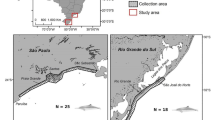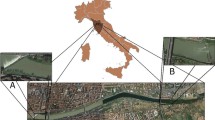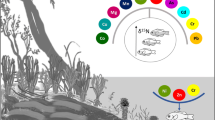Abstract
Mercury concentration [Hg] was assessed in 20 adult Allis shad Alosa alosa (54–59 cm) and 20 adult Twaite shad Alosa fallax (36–44 cm) collected during their spawning migration in the Dordogne and the Garonne rivers (France). [Hg] was measured in the gills, dorsal muscle, liver and kidney. Twaite shad exhibited higher [Hg] than Allis shad. Median [Hg] values were [Hg]Gills=0.33 μg g−1 (dw), [Hg]Muscle=1.22 μg g−1, [Hg]Liver=1.99 μ g−1, [Hg]Kidney=1.93 μg g−1 for Twaite shad and [Hg]Gills=0.06 μg g−1, [Hg]Muscle=0.20 μg g−1, [Hg]Liver=1.18 μg g−1, [Hg]Kidney=1.08 μg g−1 for Allis shad. In order to understand such differences, we investigated some life history traits of the two species: migratory history, age (3–6 years), size at age (an expression of growth) and the number of spawning events (0–2 events). The difference in estuarine residence time between the juveniles of both species, which was assumed to influence [Hg], was investigated using otolith Sr:Ca ratio. The microchemical analysis revealed a significant difference in the residence time of juveniles in the estuary (medians are 21 d and 10 d for Twaite shad and Allis shad, respectively) but this residence time seems too short to influence [Hg] (Allis shad: r spearman<0.128; Twaite shad: r spearman<−0.340). As both species show the same age structure, the influence of age on [Hg] was negligible. The literature shows that the differences in growth and in the number of spawning events reported in our study are in favour of a higher [Hg] for Twaite shad than for Allis shad. Although trophic status was not investigated here, the literature reveals that it is another factor that could produce higher [Hg] in Twaite shad, since its diet includes higher trophic levels than Allis shad.
Guest editors: S. Dufour, E. Prévost, E. Rochard & P. Williot Fish and diadromy in Europe (ecology, management, conservation)
Access this chapter
Tax calculation will be finalised at checkout
Purchases are for personal use only
Preview
Unable to display preview. Download preview PDF.
Similar content being viewed by others
References
Agusa, T., T, Kunito, S. Tanabe, M. Pourkazemi & D. G. Aubrey, 2004. Concentrations of trace elements in muscle of sturgeons in the Caspian Sea. Marine Pollution Bulletin 49: 789–800.
Aprahamian, M. W., 1989. The diet of juvenile and adult Twaite shad Alosa fallax fallax (Lacépede) from the rivers Severn and Wye (Britain). Hydrobiologia 179: 173–182.
Aprahamian, M. W., J. L. Baglinierère, M. R. Sabatié, P. Alexandrino, R. Thiel & C. D. Aprahamian, 2003. Biology, status, and conservation of the anadromous Atlantic Twaite shad Alosa fallax fallax. In Limburg, K. E. & J. R. Waldman (eds), Biodiversity, Status, and Conservation of the World’s Shads. American Fisheries Society, Bethesda, Maryland: 103–124.
Baeyens, W., M. Leermakers, T. Papina, A. Saprykin, N. Brion, J. Noyen, M. De Gieter, M. Elskens & L. Goeyens, 2003. Bioconcentration and biomagnification of mercury and methylmercury in North Sea and Scheldt estuary fish. Archives of Environmental Contamination and Toxicology 45: 498–508.
Baglinière, J. L., M. R. Sabatié, M. W. Aprahamian, P. J. Alexandrino, C. D. Aprahamian, C. A. Assis, J. J. Cassou-Leins, M. Le Corre, C. Mennesson-Boisneau, D. Martin-Vandembulcke, E. Rochard & C. Teixeira, 2001. Guide pour l’interprétation des écailles et l’estimation de l’âge chez les aloses (Alosa sp) de la façade Atlantique-Est et de la Méditerranée-Ouest. Bulletin Français de la Pêche et de la Pisciculture 357/360: 485–530.
Baglinière, J. L., M. R. Sabatié, E. Rochard, P. Alexandrino & M. W. Aprahamian, 2003. The Allis shad Alosa alosa: biology, ecology, range and status of populations. In Limburg, K. E. & J. R. Waldman (eds), Biodiversity. Status, and Conservation of the World’s Shads. American Fisheries Society, Bethesda, Maryland: 85–102.
Boudou, A, & F. Ribeyre, 1997. Mercury in the food web: accumulation and transfer mechanisms. In Sigel, A & H. Sigel (eds), Metal ions in Biological Systems, Mercury and its effects on Environment and Biology. Marcel Dekker, New York: 289–319.
Cabañero, A. I., C. Carvalho, Y. Madrid, C. Batoréu & C. Camára, 2005. Quantification and speciation of mercury and selenium in fish samples of high consumption in Spain and Portugal. Biological Trace Element Research 103: 17–35.
Campana, S. E. & S. R. Thorrold, 2001. Otoliths, increments, and elements: keys to a comprehensive understanding of fish populations? Canadian Journal of Fisheries and Aquatic Sciences 58: 30–38.
Cassou-Leins, F. & J. J. Cassou-Leins 1981. Recherches sur la biologie et l’halieutique des migrateurs de la Garonne et principalement de l’alose Alosa alosa L. Ph.D thesis. Institut National Polytechnique, Toulouse, 382p.
Castelnaud, G., E. Rochard & Y. Le Gat, 2001. Analyse de la tendance de l’abondance de l’alose Alosa alosa en Gironde à partir de l’estimation d’indicateurs halieutiques sur la période 1977–1998. Bulletin Français de la Pêche et de la Pisciculture 362/363: 989–1015.
Cordier, S., M. Garel, L. Mandereau, H. Morcel, P. Doineau, S. Gosme-Seguret, D. Josse, R. White & C. Amiel-Tison, 2002 Neurodevelopmental investigations among methylmercury-exposed children in French Guiana. Environmental Research 89: 1–11.
Cossa, D. & J. Noël, 1987. Concentrations of mercury in near shore surface waters of the bay of Biscay and in the Gironde estuary. Marine Chemistry 20: 389–396.
Cossa, D., D. Auger, B. Averty, M. Luçon, P. Masselin, J. Noël & J. Sanjuan, 1990. Niveaux de concentration en métaux. métalloïdes et composés organochlorés dans les produits de la pêche côtière française. Rapport IFREMER, 59p.
Daverat, F., J. Tomás, M. Lahaye, M. Palmer & P. Elie, 2005. Tracking continental habitat shifts of eels using Sr/Ca ratios: validation and application to the coastal, estuarine and riverine eels of the Gironde-Garonne-Dordogne watershed. Marine and Freshwater Research 56: 619–627.
Durrieu, G., R. Maury-Brachet, M. Girardin, E. Rochard & A. Boudou, 2005a. Contamination by heavy metals (Cd, Zn, Cu, and Hg) of eight fish species in the Gironde estuary (France). Estuaries 28: 581–591.
Durrieu, G., R. Maury-Brachet & A. Boudou, 2005b. Goldmining and mercury contamination of the piscivorous fish Hoplias aimara in French Guiana (Amazon basin). Ecotoxicology and Environmental Safety 60: 315–323.
Frery, N., R. Maury-Brachet, E. Maillot, M. Deheeger, B. Merone & A. Boudou, 2001. Goldmining activities and mercury contamination of native amerindian communities in French Guiana: key role of fish in dietary uptake. Environmental Health Perspectives 109: 1–5.
Gazeau, C., T. Lefrançois & E. Rochard, 2001. Mise en place d’une démarche qualité dans le cadre de l’échantillonnage d’une population de grande alose (Alosa alosa). Bulletin Français de la Pêche et de la Pisciculture 362/363: 1017–1024.
Hall, B. D., R. A. Bodaly, R. J. P. Fudge, J. W. M. Rudd & D. M. Rosenberg. 1997. Food as the dominant pathway of methylmercury uptake by fish. Water. Air, and Soil Pollution 100: 13–24.
Hammar, J., P. Larsson & M. Klavins, 1993. Accumulation of persistent pollutants in normal and dwarfed Artic charr (Salvelinus alpinus sp. complex). Canadian Journal of Fisheries and Aquatic Sciences 50: 2574–2580.
Harris, R. C. & R. A. Bodaly, 1998. Temperature, growth and dietary effects on fish mercury dynamics in two Ontario lakes. Biogeochemistry 40: 175–187.
Ikingura, J. R. & H. Akagi, 2003. Total mercury and methylmercury levels in fish from hydroelectric reservoirs in Tanzania. The Science of the Total Environment 304: 355–368.
Kafemann, R., S. Adlerstein & R. Neukamm, 2000. Variation in otolith strontium and calcium ratios as an indicator of life-history strategies of freshwater fish species within a brackish water system. Fisheries Research 46: 313–325.
Limburg, K. E., 1995. Otolith strontium traces environmental history of subyearling American shad Alosa sapidissima. Marine Ecology Progress Series 119: 25–35.
Limburg, K. E., 1996. Growth and migration of 0-year American shad (Alosa sapidissima) in the Hudson River estuary: otolith microstructural analysis. Canadian Journal of Fisheries and Aquatic Sciences 53: 220–238.
Limburg, K. E., 2001. Through the gauntlet again: demographic restructuring of American shad by migration. Ecology 82: 1584–1596.
Lobry, J., L. Mourand, E. Rochard & P. Elie, 2003. Structure of the Gironde estuarine fish assemblages: a comparison of European estuaries perspective. Aquatic Living Resources 16: 47–58.
Lochet, A., 2006. Dévalaison des juvéniles et tactiques gagnantes chez la grande alose Alosa alosa et l’alose feinte Alosa fallax: apports de la microchimie et de la microstructure des otolithes. Ph.D thesis. University of Bordeaux I, Bordeaux, 208p.
Maitland, P. S. & A. A. Lyle, 2005. Ecology of Allis Shad Alosa alosa and Twaite Shad Alosa fallax in the Solway Firth, Scotland. Hydrobiologia 534: 205–221.
Martin Vandembulcke, D., 1999. Dynamique de population de la grande alose (Alosa alosa, L. 1758) dans le bassin versant Gironde-Dordogne-Garonne (France): analyse et prévision par modélisation. Ph.D thesis, INP-ENSAT, Toulouse, 114p.
Mol, J. H., J. S. Ramlal, C. Lietar & M. Verloo, 2001. Mercury contamination in freshwater, estuarine, and marine fishes in relation to small-scale gold mining in Suriname. South America. Environmental Research Section A 86: 183–197.
Niimi, A. J., 1983. Biological and toxicological effects of environmental contaminants in fish and their eggs. Canadian Journal of Fisheries and Aquatic Sciences 40: 306–312.
Oesmann, S. & R. Thiel, 2001. Feeding of juvenile Twaite shad (Alosa fallax Lacépède, 1803) in the Elbe estuary. Bulletin Français de la Pêche et de la Pisciculture 362/363: 785–800.
O’Leary, J. A. & B. Kynard, 1986. Behavior, length and sex ratio of seaward migrating juvenile American shad and blueback herring in the Connecticut River. Transactions of the American Fisheries Society 115: 529–536.
Power, M., G. M. Klein, K. R. R. A. Guiguer & K. H. Kwan, 2002. Mercury accumulation in the fish community of a sub-Arctic lake in relation to trophic position and carbon sources. Journal of Applied Ecology 39: 819–830.
Riget, F., G. Asmund & P. Aastrup, 2000. Mercury in Arctic char (Salvelinus alpinus) populations from Greenland. The Science of the Total Environment 245: 161–172.
Roulet, M. & R. Maury-Brachet, 2001. Le mercure dans les organismes aquatiques amazoniens (Annexe 4). In IRD (ed.), Le mercure en Amazonie, Paris: 204–271.
Sabatié, R., 1993. Recherches sur l’écologie et la biologie des aloses au Maroc (Alosa alosa Linné, 1758 et Alosa fallax Lacépède, 1803): exploitation et taxonomie des populations atlantiques, bioécologie des aloses de l’Ouest Sebou. Ph.D thesis, University of Bretagne Occidentale, Brest. 326p.
Salomon, J. N., 2002. L’inondation dans la basse vallée de la Garonne et l’estuaire de la Gironde lors de la “tempête du siècle” (27–28 décembre 1999). Géomorphologie: relief, processus, environnement 2: 127–134.
Secor, D. H., J. Mark Dean, & E. H. Laban, 1992. Otolith removal and preparation for microstructural examination. In Stevenson, D. K. & S. E. Campana (eds), Otolith microstructure examination and analysis. Canadian Special Publication of Fisheries and Aquatic Sciences 17: 19–57.
Secor, D. H., A. Henderson-Arzapalo & P. M. Piccoli, 1995. Can otolith microchemistry chart patterns of migration and habitat utilization in anadromous fishes? Journal of Experimental Marine Biology and Ecology 192: 15–33.
Siegel, S. & N. J. Castellan, 1988. Nonparametric statistics for the behavioral sciences. 2nd edn. McGraw-Hill, New York.
Simon, O., & A. Boudou, 2001. Direct and trophic contamination of the herbivorous carp Ctenopharyngodon idella by inorganic mercury and methylmereury. Ecotoxicology and Environmental Safety 50: 48–59.
Simoneau, M., M. Lucotte, S. Garceau & D. Laliberté, 2005. Fish growth rates modulate mercury concentrations in walleye (Sander vitreus) from eastern Canadian lakes. Environmental Research 98: 73–82.
Slemr, F. & E. Langer, 1992. Increase in global atmospheric concentrations of mercury inferred from measurements over the Atlautic Ocean. Nature 355: 434–437.
Taverny, C., 1991. Contribution à la connaissance de la dynamique des populations d’aloses (Alosa alosa et Alosa fallax) dans le système fluvio-estuarien de la Gironde: pêche, biologie et écologie. Etude particulière de la dévalaison et de l’impact des activités humaines. Ph.D thesis, University of Bordeaux 1, Bordeaux, 568p.
Taverny, C. & P. Elie, 2001a. Répartition spatio-temporelle de la grande alose Alosa alosa (Linné, 1766) et de l’alose feine Alosa fallax (Lacépède, 1803) dans le golfe de Gascogne. Bulletin Français de la Pêche et de la Pisciculture 362/363: 801–821.
Taverny, C. & P. Elie, 2001b. Régime alimentaire de la grande alose Alosa alosa (Linné, 1766) et de l’alose feine Alosa fallax (Lacépède, 1803) dans le golfe de Gascogne. Bulletin Français de la Pêche et de la Pisciculture 362-363: 837–852.
Trudel, M., A. Tremblay, R. Schetagne & J. B. Rasmussen, 2000. Estimating food consumption rates of fish using a mercury mass balance model. Canadian Journal of Fisheries and Aquatic Sciences 57: 414–428.
Tseng, C. M., D. Amouroux, G. Abril, E. Tessier, H. Etcheber & O. F. Donard, 2001. Speciation of mercury in a fluid mud profile of a highly turbid macrotidal estuary (Gironde. France). Environmental Science and Technology 35: 2627–2633.
Watras, C. J., R. C. Back, S. Halvorsen, R. J. M. Hudson, K. A. Morrison & S. P. Wente, 1998. Bioaccumulation of mercury in pelagic freshwater food webs. The Science of the Total Environment 219: 183–208.
WHO (World Health Organization), 1990. Environmental health criteria, 101. Methylmercury. WHO/ICPS, Geneva.
Zahir, F., S. J. Rizwi, S. K. Haq & R. H. Khan, 2005. Low dose mercury toxicity and human health. Environmental Toxicology and Pharmacology 20: 351–360.
Author information
Authors and Affiliations
Corresponding author
Editor information
Editors and Affiliations
Rights and permissions
Copyright information
© 2008 Springer Science+Business Vledia B. V.
About this chapter
Cite this chapter
Lochet, A. et al. (2008). Mercury contamination and life history traits of Allis shad Alosa alosa (Linnaeus, 1758) and Twaite shad Alosa fallax (Lacépède, 1803) in the gironde estuary (South West France). In: Dufour, S., Prévost, E., Rochard, E., Williot, P. (eds) Fish and Diadromy in Europe (ecology, management, conservation). Developments in Hydrobiology, vol 200. Springer, Dordrecht. https://doi.org/10.1007/978-1-4020-8548-2_8
Download citation
DOI: https://doi.org/10.1007/978-1-4020-8548-2_8
Publisher Name: Springer, Dordrecht
Print ISBN: 978-1-4020-8547-5
Online ISBN: 978-1-4020-8548-2
eBook Packages: Biomedical and Life SciencesBiomedical and Life Sciences (R0)




